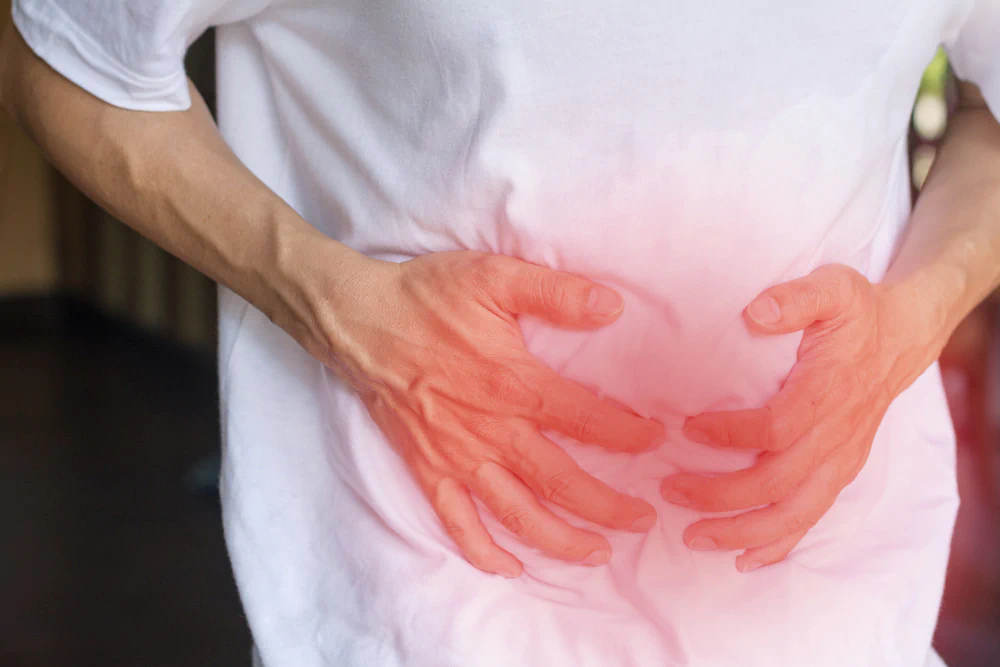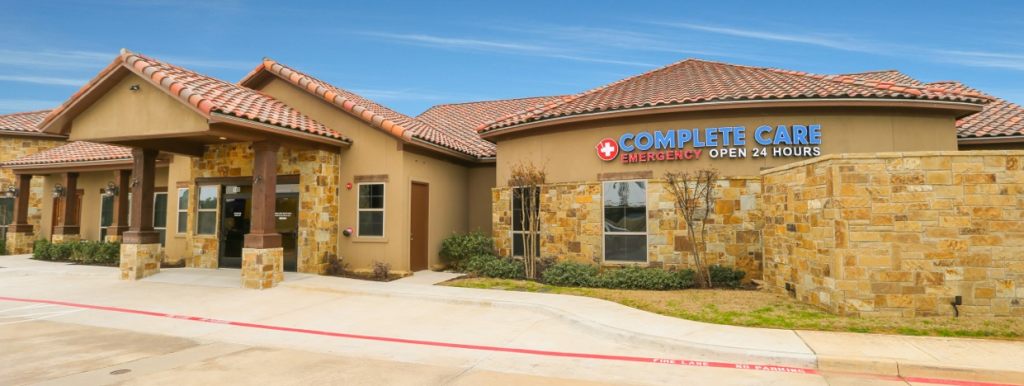What Do Diverticulitis Symptoms Feel Like?
Abdominal Pain
•
Jun 6, 2025
Reviewed by:

Diverticulitis occurs when small pouches (diverticula) that form in the wall of your colon become inflamed or infected. While diverticulosis (the mere existence of these pouches) is common and often causes no symptoms, it can be painful and potentially serious if inflamed diverticula are left untreated. Understanding what diverticulitis symptoms feel like can help you recognize when to seek medical attention.
Diverticulitis symptoms may include:
- Sharp, persistent pain, typically on the lower left side of your abdomen
- Fever and chills
- Nausea and vomiting
- Constipation or, less commonly, diarrhea
- Bloating and gas
- Tenderness when touching your abdomen
- Changes in bowel habits
- Blood in stool (in some cases)
If you’re experiencing these symptoms, don’t wait for them to worsen. Complete Care’s freestanding ER locations offer comprehensive evaluation and treatment for diverticulitis and other digestive conditions. Our experienced medical team can provide prompt diagnosis, effective pain management, and personalized treatment plans to help you recover quickly and prevent complications.
For life-threatening situations, please call 911.
What is diverticulitis?
Diverticulitis develops when diverticula — or small pouches in the colon wall — become infected with bacteria, often when stool or partially digested food blocks their openings. This infection triggers inflammation, which can spread to surrounding tissues and potentially lead to complications such as abscesses, perforations, or fistulas if left untreated.
The condition is largely influenced by lifestyle factors, with low-fiber Western diets being a primary contributor. Other risk factors include age (particularly after 40), obesity, smoking, sedentary habits, and certain medications like steroids and NSAIDs. Genetics may also play a role, as some individuals appear to have a hereditary predisposition to developing weakened areas in their colon wall.
What does the beginning of diverticulitis feel like?
The initial onset of diverticulitis often begins with a persistent, achy lower left side pain that gradually intensifies over several days. Unlike the sudden sharp pain of conditions like appendicitis, early diverticulitis discomfort may start subtly and worsen steadily. Many people describe it as a constant, localized tenderness that becomes increasingly difficult to ignore.
In these early stages, you might also notice subtle changes in your bowel habits before more pronounced symptoms develop. Mild nausea, slight fever, and a general feeling of unwellness often accompany the abdominal discomfort. Some people report feeling unusually fatigued or experiencing reduced appetite even before recognizing that something is wrong with their digestive system.
How do I know if my pain is diverticulitis: recognizing the symptoms
Sharp, persistent pain, typically on the lower left side of your abdomen
The hallmark symptom of diverticulitis is pain in the lower left abdomen where the sigmoid colon is located. This pain differs from other conditions like irritable bowel syndrome location, which typically causes more generalized discomfort. Diverticulitis pain is often described as sharp, severe, and constant, sometimes worsening with movement. The intensity and persistence of this pain are important indicators that may distinguish it from common digestive upset.
Fever and chills
When diverticulitis becomes infected, your body responds by raising its temperature to fight the infection. A fever, often accompanied by chills, is your immune system’s way of combating the bacteria causing the inflammation. While low-grade fevers (below 100.4°F) can be managed at home as part of initial diverticulitis treatment, higher temperatures may indicate a more serious infection. When fever exceeds 102°F alongside abdominal pain, this combination warrants immediate medical attention as it suggests a potentially severe infection that requires aggressive intervention.
Nausea and vomiting
The inflammation and infection associated with diverticulitis can trigger nausea and vomiting by disrupting normal digestive processes. Your body may respond to the infection by attempting to purge its contents. These symptoms often appear alongside the primary abdominal pain and can significantly impact your ability to maintain proper hydration and nutrition. Persistent vomiting that prevents you from keeping down liquids represents a serious concern as it can quickly lead to dehydration and electrolyte imbalances.
Constipation or, less commonly, diarrhea
Bowel habit changes are common with diverticulitis, as the inflamed colon struggles to function normally. Constipation often occurs because the inflamed area narrows the passage through which stool must travel, while inflammation can also disrupt normal muscle contractions. In some cases, diarrhea may occur instead, particularly if the inflammation irritates the colon lining. These symptoms can sometimes be confused with other conditions, so it’s important to note their association with the characteristic abdominal pain of diverticulitis rather than assuming they’re related to less serious conditions.
Bloating and gas
As diverticulitis disrupts normal digestive function, excessive gas production and trapped air can cause significant bloating and distension of the abdomen. This bloating often feels different from routine gas — it’s typically more persistent and may be accompanied by visible swelling of the abdomen. The pressure from this bloating can exacerbate the pain from the inflamed diverticula. While bloating alone is rarely a reason for emergency care, when combined with severe pain and other symptoms, it contributes to the overall clinical picture that may indicate when to go to the ER for diverticulitis symptoms.
Tenderness when touching your abdomen
One of the most reliable physical signs of diverticulitis is pronounced tenderness when the affected area of the abdomen is touched or pressed. This tenderness often feels sharper and more localized than the general discomfort associated with conditions like irritable bowel syndrome. Healthcare providers specifically look for this sign during physical examinations, as it helps differentiate diverticulitis from other conditions. The area may also feel firm or rigid, indicating inflammation and possibly the body’s attempt to “wall off” the infected area.
Changes in bowel habits
Beyond constipation and diarrhea, diverticulitis can cause other changes in your normal bowel routine. You might experience a sense of incomplete evacuation after bowel movements or notice changes in the frequency of bowel movements. These changes typically develop gradually over several days as inflammation worsens. While many conditions can cause altered bowel habits, when these changes occur alongside lower left abdominal pain, diverticulitis becomes a more likely explanation than common conditions like irritable bowel syndrome.
Blood in stool (in some cases)
What does poop look like with diverticulitis flare up? While not present in all cases, blood in the stool can occur with diverticulitis when the inflamed pouches bleed. This blood may appear bright red, maroon, or even black and tarry, depending on where the bleeding occurs and how quickly the blood passes through your digestive system. Any visible bleeding should be taken seriously, as it may indicate complications requiring prompt medical attention. Significant bleeding is not typical of uncomplicated diverticulitis and may suggest other issues like perforation or concurrent conditions requiring different treatment approaches.
Additional considerations for diagnosis
When evaluating potential diverticulitis, healthcare providers also check for normal blood pressure, as a drop could indicate serious complications like sepsis. They’ll also consider conditions with similar symptoms, such as kidney stones (which typically cause pain that radiates to the groin) and irritable bowel syndrome (which causes discomfort but rarely fever or severe localized pain). The combination of symptoms, rather than any single sign, helps differentiate diverticulitis from other conditions and determines the appropriate diverticulitis treatment approach.
Diverticulitis: when to go to the hospital
While mild diverticulitis can often be managed at home with rest, antibiotics, and dietary modifications as part of standard diverticulitis treatment, the following symptoms signal a medical emergency that requires immediate attention.
- Severe, intense abdominal pain that is constant or worsening
- High fever (above 102°F or 38.9°C)
- Persistent vomiting that prevents keeping down liquids or medications
- Signs of bleeding such as blood in stool or rectal bleeding
- Inability to have a bowel movement, especially if accompanied by vomiting
- Rigid, hard abdomen that is extremely tender to touch
- Symptoms of shock including rapid heart rate, confusion, or dizziness
- Fainting or loss of consciousness
- Significant worsening of symptoms despite following prescribed treatment
The question of when to go to the hospital for diverticulitis symptoms is a critical one, as delaying care for severe symptoms can lead to life-threatening complications such as perforation, abscess formation, peritonitis, or bowel obstruction. If you experience any of these warning signs, don’t attempt to self-diagnose or wait it out.
Experience the Complete Care difference for diverticulitis relief.
Living with diverticulitis symptoms doesn’t have to be your new normal. From persistent abdominal pain and fever to uncomfortable bloating and bowel changes, these symptoms can significantly impact your quality of life when left untreated. Complete Care offers expert diagnosis and treatment for diverticulitis at all our convenient freestanding emergency room locations across Texas and Colorado.
Whether you’re in Austin, Corpus Christi, Dallas/Fort Worth, East Texas, Lubbock, San Antonio, or Colorado Springs, our medical professionals are ready to provide the prompt care you need. With lower wait times than a traditional hospital ER, we’re committed to helping you find relief quickly and effectively.
Don’t let diverticulitis pain control your life for another day. Visit your nearest Complete Care ER location now for compassionate, comprehensive treatment that puts you on the path to recovery.
More Helpful Articles by Complete Care:
- What Causes Shortness of Breath?
- How to Prevent Trampoline Injuries
- When to Go to the ER for Pneumonia Treatment
- Working With a Loved One Through Denial of Medical Treatment
- What Does Cellulitis Look Like on the Leg?
